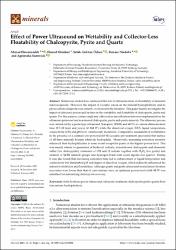| dc.contributor.author | Hassanzadeh, Ahmad | |
| dc.contributor.author | Gholami, Hamed | |
| dc.contributor.author | Özkan, Şafak Gökhan | |
| dc.contributor.author | Niedoba, Tomasz | |
| dc.contributor.author | Surowiak, Agnieszka | |
| dc.date.accessioned | 2021-02-24T08:20:19Z | |
| dc.date.available | 2021-02-24T08:20:19Z | |
| dc.date.issued | 2021 | en_US |
| dc.identifier.issn | 2075-163X | |
| dc.identifier.uri | https://hdl.handle.net/20.500.12846/507 | |
| dc.description.abstract | Numerous studies have addressed the role of ultrasonication on floatability of minerals macroscopically. However, the impact of acoustic waves on the mineral hydrophobicity and its physicochemical aspects were entirely overlooked in the literature. This paper mainly investigates the impact of ultrasonic power and its time on the wettability and floatability of chalcopyrite, pyrite and quartz. For this purpose, contact angle and collectorless microflotation tests were implemented on the ultrasonic-pretreated and non treated chalcopyrite, pyrite and quartz minerals. The ultrasonic process was carried out by a probe-type ultrasound (Sonopuls, 20 kHz and 60 W) at various ultrasonication time (0.5-30 min) and power (0-180 W) while the dissolved oxygen (DO), liquid temperature, conductivity (CD) and pH were continuously monitored. Comparative assessment of wettabilities in the presence of a constant low-powered (60 W) acoustic pre-treatment uncovered that surface of all three minerals became relatively hydrophilic. Meanwhile, increasing sonication intensity enhanced their hydrophilicities to some extent except for quartz at the highest power-level. This was mainly related to generation of hydroxyl radicals, iron-deficient chalcopyrite and elemental sulfur (for chalcopyrite), formation of OH and H radicals together with H2O2 (for pyrite) and creation of SiOH (silanol) groups and hydrogen bond with water dipoles (for quartz). Finally, it was also found that increasing sonication time led to enhancement of liquid temperature and conductivity but diminished pH and degree of dissolved oxygen, which indirectly influenced the mineral wettabilities and floatabilities. Although quartz and pyrite ultrasound-treated micro-flotation recoveries were lower than that of conventional ones, an optimum power-level of 60-90 W was identified for maximizing chalcopyrite recovery. | en_US |
| dc.language.iso | eng | en_US |
| dc.publisher | MDPI-Multidisciplinary Digital Publishing Institute | en_US |
| dc.relation.isversionof | 10.3390/min11010048 | en_US |
| dc.rights | info:eu-repo/semantics/openAccess | en_US |
| dc.subject | Froth Flotation | en_US |
| dc.subject | Power Ultrasound | en_US |
| dc.subject | Ultrasonic Treatment | en_US |
| dc.subject | Hydrophobicity | en_US |
| dc.title | Effect of power ultrasound on wettability and collector-less floatability of chalcopyrite, pyrite and quartz | en_US |
| dc.type | article | en_US |
| dc.relation.journal | Minerals | en_US |
| dc.contributor.authorID | 0000-0002-7770-7480 | en_US |
| dc.identifier.volume | 11 | en_US |
| dc.identifier.issue | 1 | en_US |
| dc.relation.publicationcategory | Makale - Uluslararası Hakemli Dergi - Kurum Öğretim Elemanı | en_US |
| dc.contributor.department | TAÜ, Fen Bilimleri Enstitüsü, Robotlar ve Akıllı Sistemler Ana Bilim Dalı Koleksiyonu | en_US |
| dc.contributor.institutionauthor | Özkan, Şafak Gökhan | |
| dc.identifier.wosquality | Q2 | en_US |
| dc.identifier.scopusquality | Q2 | en_US |
| dc.identifier.wos | WOS:000610597700001 | en_US |

















